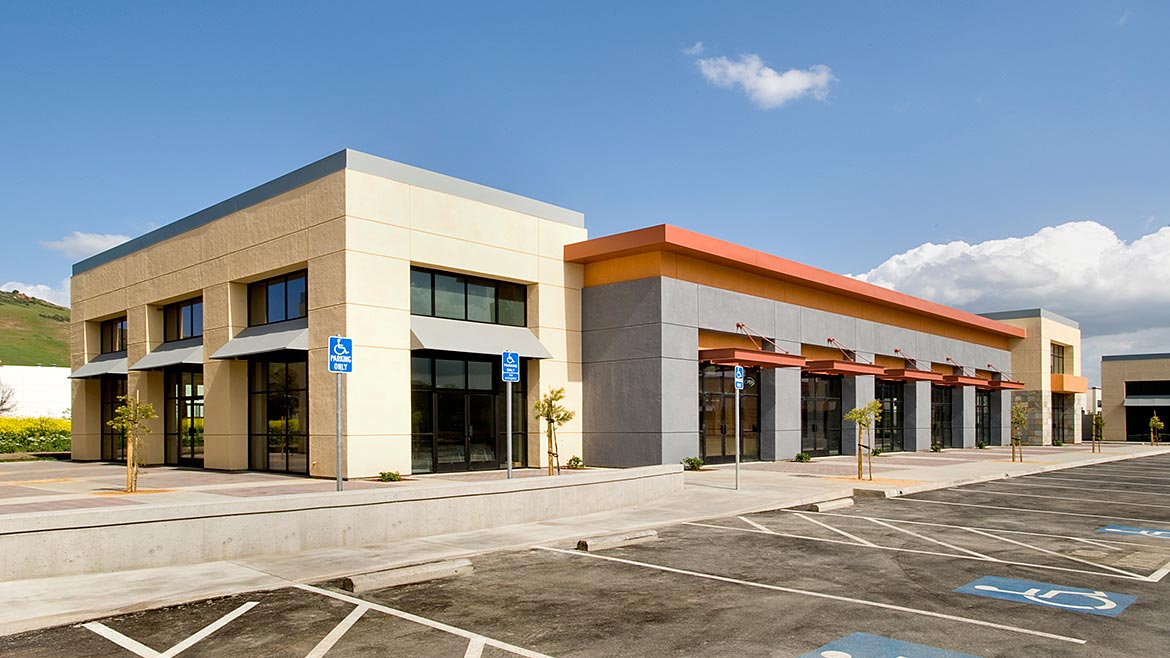Stucco for the 21st Century

Image Credit: alacatr / iStock / Getty Images Plus via Getty Images.
New cladding systems continue trickling into the market, hoping to be the next big thing.
Stucco is the one cladding that has been a durable staple for the construction industry for over a century, and for good reasons. Stucco is fire-resistant and pest-resistant, and helps reduce sound transmission. For designers, stucco is incredibly versatile when it comes to color and texture, and architectural detailing options are limitless.
However, stucco’s longevity places it in a class of its own. Stucco structures can last well over 60 years with simple maintenance. Stucco can add to the sheer value of the exterior wall and expand and contract with the weather, and it’s also resistant to mold, rot and mildew.
While all those features and benefits are great, can stucco stack up against the design criteria of the 21st Century?
Thanks to a collaborative effort from hard-working professionals, the building industry has placed new standards on stucco over wood-based sheathing through the 2021 International Building Code.
It’s a well-known fact that excessive moisture content in the exterior wall can lead to many other issues. For this reason, some enhanced practices are essential to protect the moisture-sensitive portions of the wall assembly from getting damp from inward vapor drives.
The 2021 editions of the International Building Code and International Residential Code drainage mat manufacturers and stucco accessory manufacturers have effectively responded.
In section 2510.6 of the IBC 2021, it reads as follows:
“2510.6 Water-Resistive Barriers. WRBs shall be installed as required in Section 1403.2 and, where applied over wood-based sheathing, shall comply with Section 2510.6.1 or Section 2510.6.2.
2510.6.1 Dry Climates. One of the following shall apply for dry (B) climate zones:
The water-resistive barrier shall be two layers of 10-minute Grade D paper or have a water resistance equal to or greater than two layers of water-resistive barrier complying with ASTM E2556, Type I. The individual layers shall be installed independently such that each layer provides a separate continuous plane and any flashing, installed in accordance with Section 1404.4 and intended to drain to the water-resistive barrier, is directed between the layers.
The water-resistive barrier shall be 60-minute Grade D paper or have a water resistance equal to or greater than one layer of water-resistive barrier complying with ASTM E2556, Type II. The water-resistive barrier shall be separated from the stucco by a layer of foam plastic insulating sheathing or other non-water absorbing layer.
2510.6.2 Moist or marine climates. In moist (A) or marine (C) climate zones, water-resistive barrier shall comply with one of the following:
In addition to complying with Item 1 or 2 of Section 2510.6.1, a minimum 3/16 inch (4.8 mm) space shall be added to the exterior side of the water-resistive barrier.
In addition to complying with Item 2 of Section 2510.6.1, a space with a minimum drainage efficiency of 90 percent as measured in accordance with ASTM E2273 or Annex A2 of ASTM E2925 is added to the exterior side of the water-resistive barrier.

Climate Zone
This change will impact a sizable portion of the United States. The International Energy Conservation Code divides the United States into climate zones, and the result is that a very major portion of the United States will fall under the new requirement.
Depending on your climate zone, you may now be required to add a minimum 3/16-inch-thick drainage mat material or open plane between the water-resistive barrier and the cement plaster. This is nothing new for many parts of the U.S., as many building envelope consultants have already started implementing drainage mats into stucco assemblies.
The 3/16-inch space they reference in the code can be achieved in various ways. However, drainage mats provide consistency to the thickness of the stucco cladding, while also providing a 90 percent drainage efficiency to maintain adequate drying and air circulating between the substrate and the stucco. Drainage mats or rainscreens can be made from polymer fused entangled filaments, dimpled plastic boards and textured house-wrap material. When selecting a drainage mat, look for manufacturers that offer a complete line of compatible products. The drainage mat is just one part of the assembly, as self-adhered flashing and sealants will also be required, and they should all be compatible.
 3 millimeter (green) VaproMat with attached filter fabric applied over WrapShield SA WRB/AB creates a cost effective, positive drainage cavity.
3 millimeter (green) VaproMat with attached filter fabric applied over WrapShield SA WRB/AB creates a cost effective, positive drainage cavity.
There are two essential components of a successful rain screen stucco assembly. The WRB/AB component and the drainage cavity material. Starting from the exterior sheathing and progressing outboard, the WRB/AB must be capable of providing high performance in water resistance, airflow resistance and water vapor management. Self-adhered materials work best as they limit penetrations and provide better performance at the insulation and lathing attachment points. Fluid applied systems are another option. Other factors to consider are UV resistance, fire performance and ease of installation.
The drainage cavity material is placed over the WRB/AB component to create the space needed for liquid water drainage and ventilation. In drier, hotter climates, this space also acts as a thermal separator, limiting heat transfer from the sun. Drainage cavity materials are usually made of a polypropylene entangled mesh material in various profiles and depths. Attached to this mesh is a filter fabric that serves two functions. One, the filter fabric provides stabilization of the entangled mesh, so it doesn’t compress and two, it provides a barrier against the stucco slurry filling the cavity created by the mesh. Rain screen cavity depth varies from a minimum of 3mm for very dry climates to 19 millimeter for the wettest climates. Less than 3 mm will not provide a capillary break and more than 19 millimeter can pose fastening issues for the metal lathing components of the stucco assembly. Finally, as in WRB/AB selection, entangled mesh products should be evaluated for fire performance, UV stability and ease of installation.
Additional Benefits
However, foam boards are not the only insulation that can bring a building into compliance with the Title 24 Energy Code. Mineral wool or stone wool insulation can do the same, while also providing some additional benefits. Mineral wool is non-combustible with fire-resistant properties that will not develop toxic smoke or promote flame spread in the event of a fire. Mineral wool insulation is vapor permeable, allowing for a high drying potential and mitigating the risk of mold and mildew growth while reducing the risk of condensation within the wall assembly.
Dimensionally stable by nature, these products have a small coefficient of linear expansion and contraction, and a durable thermal performance over time. A sustainable product that can be recycled and contributes toward LEED credits, mineral wool insulation also improves occupant comfort through reduced sound transmission from the exterior environment. Lastly, this insulation is insect-resistant without a requirement to be terminated away from areas of very heavy termite infestation, alleviating concerns of deterioration or corrosion issues.
 Comfortboard 80 is a rigid stone wool board designed for continuous insulation applications.
Comfortboard 80 is a rigid stone wool board designed for continuous insulation applications.
Repurposing building materials, such as foam boards, mineral wool and drainage mats into stucco claddings has allowed stucco to comply with the energy codes and design criteria of the 21st century.
However, there may still be questions about how these various building products tie together within the stucco assembly, and there are industry professionals that are at the forefront of the topic and are bringing manufacturers together for standardized details.
Throughout my career in the stucco industry, I have witnessed and repaired many water infiltration issues and discovered some common themes that lead to water infiltration. Those are improper sequencing or lapping (reverse lapping), unsealed fasteners that do not go into the framing, improper use of stucco accessories (improper detailing) and unsealed penetrations. I have found that these four areas contribute to about 90 percent of all water infiltration issues.
Once you understand the potential issues, you can avoid them with proper product selection and assembling details. When selecting stucco accessories, be sure they can be produced in custom ground sizes. Whether using a drainage mat, and mineral wool or foam board insulation, your stucco accessory will encapsulate the entire assembly to prevent reverse lapping and provide the proper drainage points to prevent moisture from being trapped within the stucco assembly.
 Assembly detail provided by Stucco For the 21st Century Task Group
Assembly detail provided by Stucco For the 21st Century Task Group
When selecting fasteners to attach lath over insulation and an air barrier/WRB, you must consider several factors to ensure long-term performance. Fastener penetrations of the air barrier or WRB located behind the layer of insulation (commonly referred to as a blind fastener penetration) can result in moisture leaks that rot inside the walls. ASTM C-1063 is the most commonly referenced standard specification for the installation of lath and typically calls for fastener spacing no greater than 7 inch by 16 inch, which translates into many penetrations of the WRB. Furthermore, securing the lath outboard of insulation creates a cantilevered load that may require stronger and larger diameter fasteners to support the weight of traditional stucco.
 Stockton Products Tru-Weep stucco accessory line provides fully customizable grounds and weep and ventilation slots
Stockton Products Tru-Weep stucco accessory line provides fully customizable grounds and weep and ventilation slots
To address moisture and structural load concerns, use corrosion-resistant screws and galvanized steel lath washers pre-assembled with tube gaskets, which enable self-sealing of the air barrier/WRB located behind the layer of continuous insulation. This simple solution helps ensure the long-term performance of the assembly.
Many design professionals can help bring your stucco cladding into code compliance for the 21st century. All manufacturers will have a technical department to point you in the right direction; some are better than others. Look for manufacturers that show details on how their products work. Building envelope consultants specializing in stucco claddings can also be a great resource.
 The Grip-Deck TubeSeal accessory is designed to help seal blind fastener penetrations of your WRB and air-barrier when mechanically attaching continuous insulation.
The Grip-Deck TubeSeal accessory is designed to help seal blind fastener penetrations of your WRB and air-barrier when mechanically attaching continuous insulation.
Reference
IBC Changes Regarding Exterior Cement Plaster by Robert Grupe is AWCI’s director of technical services
2021 I-CODES: STUCCO WRB ENHANCEMENTS
by Jay Crandell, P.E., Applied Building Technology Group / ARES Consulting,
Published on February 3, 2021.
SMA Tech Times: WRB For Portland Cement Plaster of Framed Walls
Section 2510.6 of the IBC 2021
Looking for a reprint of this article?
From high-res PDFs to custom plaques, order your copy today!







